The New Herb Garden – Row by Row – Row 2
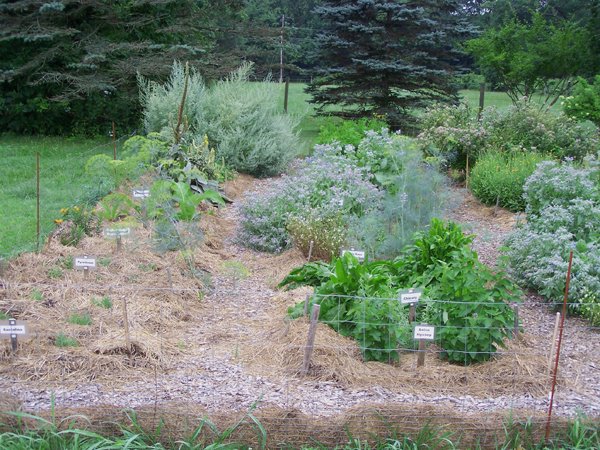
Row 2, facing west
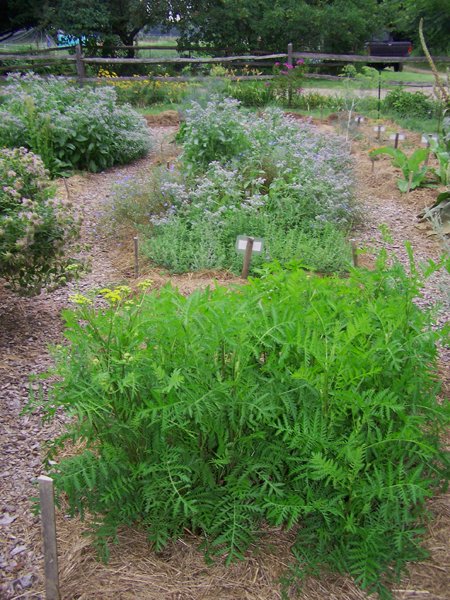
Row 2, facing east
I am doing a series on the herbs in the New Herb garden, doing each row as an entity. There are 7 rows, so there will be 7 parts to this series.
Row 2
There are 11 different herbs planted in this row. The herbs here were selected for this bed for several reasons:
• Tansy was put at an end above Wormwood because of its properties
• The lavenders were placed where they are because lavender has not ever done well here.
• Pennyroyal is in the same place as last year
• Blue flax and borage are also in the same place as last year.
• Sweet Annie is filling a space for seeds that never arrived
• Soapwort is also filling that space
• Heart’sease (Johhny Jump-ups) volunteered here
• Chicory was planted because I wanted the beautiful blue flowers
• Hyssops, Root Beer and Anise because Anise was here last year
I’ll be starting each row on the east end and working west:
Anise Hyssop Agastache foeniculum
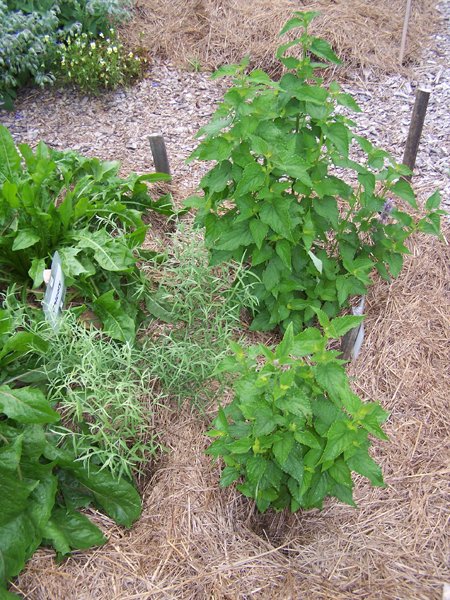
Root Beer Hyssop, left and Anise Hyssop, right
Common names: blue giant hyssop, Fragrant giant hyssop, or the lavender giant hyssop
Perennial, 2’ – 4’ high, Zones 4 – 8, prairies, upland forests, plains and fields
Flower: tubular flowers in false whorls on terminal spikes, sometimes branching at top, lavender to purple, more colorful at tips, flowering June – September
Leaf: oval toothed shape to 4” long, dull green with white tint on underside, on square stems, anise scented
Cultivation: Full sun to partial shade. Average soil, dry to medium moisture, well drained. It spreads by rhizomes or self seeding. Deadhead for additional blooming. If the soil is too wet root rot, powdery mildew, and rust can be problems.
Medicinal:
• Used as an infusion in tea and cold remedies. Will relieve congestion.
• As a cardiac herb, it is also used to strengthen a weak heart.
• Clinical research has shown that the essential oils of Anise Hyssop is antiviral toward Herpes simplex I and II.
• A poultice of Agastache foeniculum is also useful in treating burns.
• Being diaphoretic, a hot infusion will induce perspiration and is therefore useful in treating fevers.
• Indians used the leaves in incense to treat depression as it provided an uplifting fragrance.
• Can be used as a wash to treat the itchiness of poison ivy.
• A cold infusion of Agastache foeniculum leaves is used to relieve pains in the chest from excessive coughing.
• Has antibacterial and anti-inflammatory properties. Used as a preventative for summer colds.
• Used by Indians to cure wounds. Can use as a salve.
• Traditionally used to treat burns with a poultice of leaves.
• Pectoral (Used to treat lung issues) - Often combined with licorice for lung conditions such as respiratory infections and bronchitis. It is an expectorant and cough suppressant.
• It's an aromatic digestant, therefore preventing gas, bloating. Simply sip some tea with you meals to prevent gas and bloating.
• Treats diarrhea.
• Take a bath in the leaves for treating sunburn or for fungal conditions such as athlete’s foot or yeast overgrowth.
• Being aromatic, the oils in the plant are useful in opening up the airways.
• Sedative - One of the main oils in Agastache foeniculum is Methyleugenol, which has been shown to have sedative properties.
Culinary:
• Fresh or dried leaves for teas
• Fresh leaves in salads
• Fresh leaves for jellies
• Seeds in cookies and muffins
Other:
• Bee attractant
• Potpourri
• When its leaves are crushed, they have a beautifully aromatic smell of licorice
Sources:
https://en.wikipedia.org/wiki/Agastache_foeniculum
http://www.missouribotanicalgarden.org/PlantFinder/PlantFinderDetails.aspx?kempercode=d554
https://www.sandmountainherbs.com/articles/Agastache-foeniculum-medicinal-uses.html
Root Beer Hyssop Agastache rupestris

Root Beer Hyssop, left and Anise Hyssop, right
Common names: sunset hyssop, rock anise hyssop, threadleaf giant hyssop, licorice mint hyssop
Perennial, 1’ – 3’ high, Zones 5 – 10, native to mountain slopes in western US
Flower: small trumpet shaped flowers in bronze, salmon, orange, yellow with hints of purple and pink on 12” spikes, blooms all summer, has root beer aroma
Leaf: delicate blue-green or gray-green leaves with root beer aroma when touched, linear to linear-lanceolate thread-like leaves to 2” long on strong square stems
Cultivation: Full sun to partial shade. Well drained soil, drought tolerant. Doesn’t do well with compost or mulching as developed powdery mildew, root rot, or other diseases from too much moisture. Divide late spring into summer and replant. Cut to the ground in early spring for vigorous growth. Deadhead for more flowers.
Medicinal:
• Fresh or dried leaves as tea for chest diseases, coughs colds, and sore throats
Culinary:
• Fresh leaves to season foods
• Fresh leaves in salads but has bitter minty taste
Other:
• Essential oil from greens for perfume
Sources:
https://www.gardeningknowhow.com/edible/herbs/hyssop/sunset-hyssop-information.htm
https://store.underwoodgardens.com/Root-Beer-Hyssop-Agastache-rupestris/productinfo/H1055/#product-tab-description
https://www.gardenia.net/plant/agastache-rupestris
http://www.missouribotanicalgarden.org/PlantFinder/PlantFinderDetails.aspx?taxonid=254221&isprofile=0&
https://www.finegardening.com/plant/sunset-hyssop-agastache-rupestris
Chicory Cichorium intybus
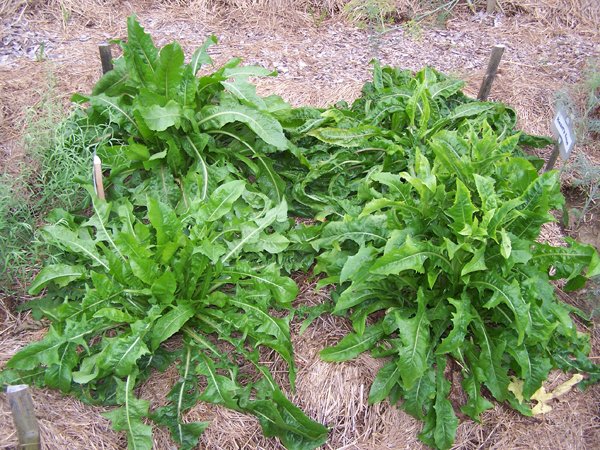
Common names: French endive, succor, blue daisy, blue dandelion, blue sailors, blue weed, bunk, coffeeweed, cornflower, hendibeh, horseweed, ragged sailors, wild bachelor's buttons, and wild endive
Flower: blue, sometimes white or pink rayed flowers, 1½” diameter, two rows of involucral bracts, the inner is longer and erect, the outer is shorter and spreading, flowers from July until October, flowers close by noon
Leaf: lance shaped and covered with hairs, off stem
Biennial, to 4’, Zones 3 – 9, along roadsides, in fields, pastures, waste areas
Cultivation: Full sun. Likes well drained soil with organic matter, pH 6.5. Prefers cool temps under 75F. Like nitrogen, needs moisture and mulching. Protect from frosts. Problems: aphids, damping off, downy mildew, flea beetles, leaf miners, cabbage worms, slugs.
Culinary:
• Cooked leaves, which are bitter, can be sautéed and added to foods
• Root used as a coffee substitute
Other:
• Forage for livestock
• May be toxic to internal parasites in animals
Sources:
https://en.wikipedia.org/wiki/Chicory
http://www.missouribotanicalgarden.org/PlantFinder/PlantFinderDetails.aspx?kempercode=a677
Heart’sease Viola tricolor
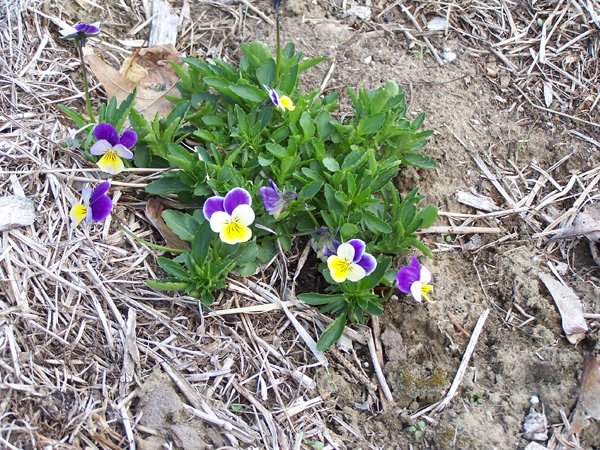
Common names: Johnny jump-up, wild pansy, viola, heart's delight, tickle-my-fancy, Jack-jump-up-and-kiss-me, come-and-cuddle-me, three faces in a hood, or love-in-idleness
Flower: dainty, fragrant blooms of deep purple, bright yellow and cream up to ¾” in size hoisted on long peduncles, flowers April to September
Leaf: alternate, oval, oblong or lanceolate with more or less serrated margins
Tender perennial, 7" - 10" high, Fall Zones 4 – 9, short grassland on farms and wasteland, chiefly on acid or neutral soils
Cultivation: Partial shade. Plenty of compost to enrich the soil and help with drainage. Watered but don’t let the soil get soggy. Pinch off dead flowers and stem ends to encourage bushier growth and more bloom production. Wilts a bit in mid-summer heat.
Medicinal:
• For epilepsy
• Asthma
• Skin diseases
• Eczema
• Helping respiratory problems such as:
• Bronchitis
• Cold symptoms
• Has expectorant properties
• Whooping cough
Culinary:
• Salads
• Floated in cocktails
• Frozen in ice cubes
• Edible decorations with a faint wintergreen taste
Source:
https://www.gardeningknowhow.com/ornamental/bulbs/violet/johnny-jump-up-flowers.htm
http://www.gardenersnet.com/flower/johnnyjumpup.htm
https://www.growplants.org/growing/viola-tricolor
https://www.fedcoseeds.com/seeds/search?item=5152
https://en.wikipedia.org/wiki/Viola_tricolor
Soapwort Saponaria ocymoides
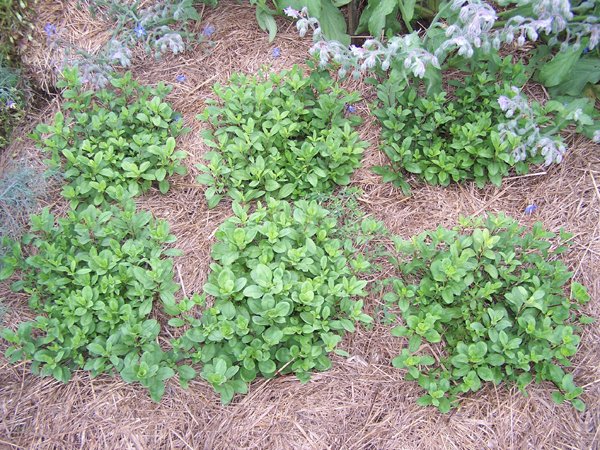
Common names: rock soapwort
Flower: tiny pink to crimson flowers borne in dense cloud-like sprays above the foliage, blooms May to August, five-petaled flowers are arranged in groups at the ends of branches, have red or pink (rarely white) petals and blue anthers
Leaf: oval leaves are gray-green and hairy with smooth edges, trailing growth, leaves 1” long, only 2 leaves in each group,
Semi-evergreen perennial, Zones 2 to 9, 8” -12” tall and 3’ across, rocky and stony places, dry slopes and forests, especially pine forests
Cultivation: Full sun. Prefers poor, sandy or rocky soil that is very well drained. Propagate by seed, cuttings, division or separation. Take cuttings in midsummer. Divide in very early spring. After first bloom, cut back the plants severely to encourage growth and a second bloom in late summer.
Medicinal:
The plant contains saponins. Although toxic, these substances are very poorly absorbed by the body and so tend to pass through without causing harm. Saponins are much more toxic to some creatures, such as fish, and hunting tribes have traditionally put large quantities of them in streams, lakes etc in order to stupefy or kill the fish
Other:
All parts of the plant are rich in saponins and can be used as a soap substitute. The saponins are extracted by simmering the plant in water. Plants can be dried for later use. A gentle and effective cleaner.
Sources:
http://www.gardening.cornell.edu/homegardening/scene0297.html
https://www.swallowtailgardenseeds.com/perennials/saponaria.html
https://en.wikipedia.org/wiki/Saponaria_ocymoides
https://pfaf.org/User/Plant.aspx?LatinName=Saponaria+ocymoides
Sweet Annie Artemisia annua
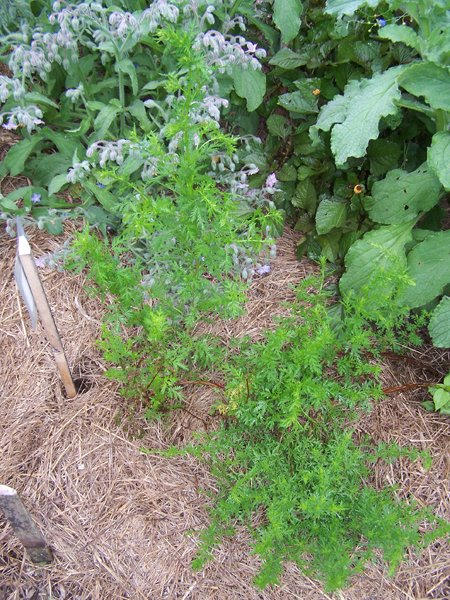
Common names: Qing Hao or Chinese wormwood, sweet wormwood, sweet sagewort, annual mugwort, annual wormwood
Flower: tiny nodding green-yellowish flowers have a diameter of ⅛” and are arranged in loose panicles
Leaf: have a length of 2”, deeply divided, and toothed, although their lobes vary in shape – linear, lance-shaped, entire or toothed, deep green, fern-like, silvery, sweet-smelling foliage, the intensive aromatic scent of the leaves is characteristic
Annual, to 6’ high, Zones 7a – 10, grows readily on hillsides, edges of forests and in wasteland
Cultivation: full sun or part shade, tolerates most soils if well-drained, will tolerate drought and water-logging, the plants are extremely vigorous and essentially disease and pest free, should be harvested at the beginning of flowering when the artemisinin content is the highest
Medicinal:
• Fevers
• To treat jaundice
• Dysentery
• Skin eruptions
• To stop wound bleeding
• Help new muscle growth
• Relieve hemorrhoids
• To prevent and treat malaria (Plasmodium falciparum), even drug-resistant strains
• Seeds to treat eye disorders
• Essential oil from the above-ground parts of the plant has proven to be:
• Antimicrobial
• Antifungal
• Antioxidant
• Can cause dermatitis and allergic reactions in susceptible individuals
• The pollen is extremely allergenic
Culinary:
• Green parts of the plant are eaten as a vegetable; the leaves contain high amounts of vitamin A
Other:
• In potpourri
• For making aromatic wreaths
• As a dyeing agent
• Essential oils of A. annua are used in cosmetics and perfumes
Sources:
https://en.wikipedia.org/wiki/Artemisia_annua
https://www.southernexposure.com/sweet-wormwood-sweet-annie-005-g-p-1138.html
http://www.herbsociety.org/file_download/inline/5d817361-5b96-4679-a23d-27f833cdb1fb
Yellow Toothache Plant Spilanthes oleracea or Acmella oleracea
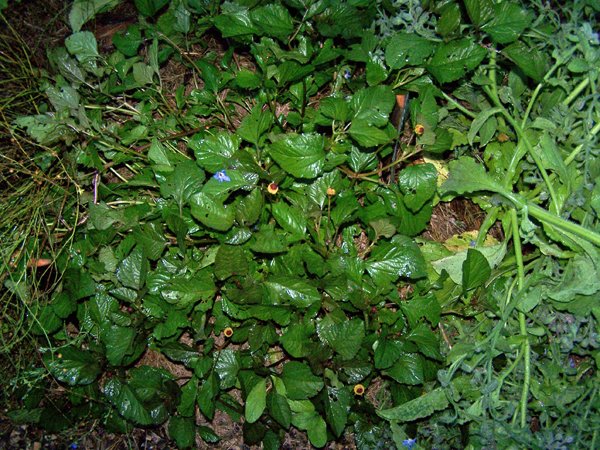
Common names: eyeball plant, peek-a-boo plant, para-cress
Flower: petal-less, oval shaped blooms, ¾” long, golden yellow with dark burgundy-red eyes, on top of long stems
Leaf: handsome, dark green foliage grows as a mound, can have a purple or bronze effect
Tender perennial, Zones 10 to 11, 12” to 18” high, 24” wide
Cultivation: Full sun to partial shade. Compost rich soil, well drained in the pH range of 6.1 to 7.5. Propagation by seed is easy. Allow seed heads to dry on the plants. Seeds can be direct-sown outdoors after the last frost. Propagate spilanthes from stem cuttings. It needs regular watering, do not allow the plant to dry out. It thrives in high humidity. To promote bushy growth wait until the fourth set of true leaves appear then pinch back the plant to the second set of true leaves. Loves water and heat.
Leaves and flower buds may be harvested on an ongoing basis for fresh use. The flower buds may be dried and stored in an airtight glass container for up to one year.
Medicinal:
• Sore throats
• Aches and pains
• A liver helper
• Tea for rheumatism
• Excessive saliva production with a cooling sensation in the throat
• Improves digestion
• Eases flatulence
• Improves the appetite
• Helps to overcome nausea and vomiting by its stimulating effect on the salivary glands
• Tea which is utilized for:
• Antifungal
• Antiviral
• Antibacterial
• Immune system stimulating properties
• A tincture can be made of the leaves and flowers of the toothache plant to help with mouth pain
• Rub the leaves on the gums of teething babies
• A crushed leave on a painful scratch
• A sialagogue (causes drooling)
Culinary:
• Eaten in small amounts in salads and they lose their strong taste once cooked
• Used in dishes such as stews
Other:
• Makes a great insecticide
• Plant it near other plants to keep bugs away
• Said to attract fireflies
Sources:
https://www.ncbi.nlm.nih.gov/pmc/articles/PMC2635640/
https://www.amerinursery.com/growing/spilanthes-oleracea/
http://oldfashionedliving.com/spilanthes.html
http://www.feathersinthewoods.com/2017/07/how-to-grow-and-use-toothache-plant.html
https://en.wikipedia.org/wiki/Acmella_oleracea
Blue Flax Linum lewisii
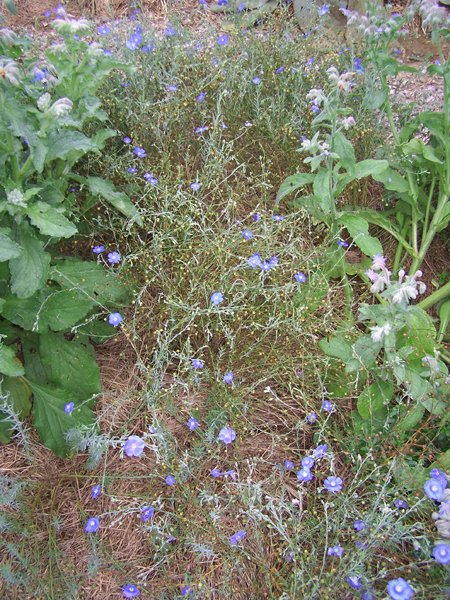
Common names: Perennial Flax, Prairie Flax
Flower: pale blue to dark blue flowers on delicate stems, open just after sunrise and close early afternoon, ¾–1" across, consisting of 5 light to medium blue petals, dark blue veins that radiate from the center of the flower, flowers May to August
Leaf: grass-like leaves, dense pseudo-whorls of small leaves, up to 1½" long, less than ¼" across, linear-oblong, gray-green or gray-blue, smooth along their margins, hairless
Perennial, Zones: 5 to 9, 1’ to 2’ high, 1’ to 1.5’ wide, roadside embankments, gravelly areas along railroads, and vacant lots where old homesites once existed
Cultivation: Full sun. Tolerates droughty soil. Requires well-drained soil. Will not overwinter in poorly drained soil. Tolerates heat. Propagate by seed, cuttings, division or separation but division is difficult. Cuttings can be taken in the spring by harvesting basal shoots when they are 5 to 10 inches long with plenty of underground stem. Needs to be trimmed back after flowering to avoid leggy appearance and encourage new growth and flowering. No serious insect or disease problems. Cutworms and grasshoppers are occasional insect pests.
Medicinal:
• Eyewash
• Boils
• Poultice of fresh leaves for eyes
Other:
• Fibers from stems are tough, for linen
• Linseed oil from seeds
Sources:
http://www.gardening.cornell.edu/homegardening/scene12cf.html
http://gilpin.extension.colostate.edu/programs/mtn-hort/blue-flax/
http://www.illinoiswildflowers.info/weeds/plants/wb_flax.htm
http://www.missouribotanicalgarden.org/PlantFinder/PlantFinderDetails.aspx?kempercode=d900
Pennyroyal Mentha pulegium
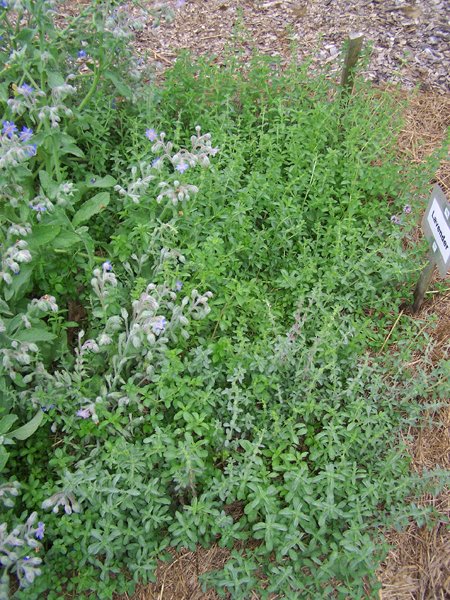
Common names: creeping pennyroyal, European pennyroyal, mint pennyroyal
Flower: lilac to pink in round whorls at leaf axils at top of stems
Leaf: bright green, peppermint scented, smooth edged or slightly toothed, hairy, oval, ½” long, glossy
Semi-hardy perennial, Zones 5 – 9, 6” – 1½’ high, moist areas along stream banks, around ponds, in irrigated fields, and in boggy grasslands
Cultivation: Damp shade, partial shade, or sun. Moist, well-drained alkaline soil rich in nutrients. Root or stem cuttings or divide in spring or fall. 1’ apart. Invasive. Remove flowering stems to avoid cross pollination with other mints. Needs plenty of moisture and feeding.
Medicinal: WARNING: pennyroyal in large doses can cause convulsions and coma.
• Don’t take if pregnant or have kidney problems
• Oil is highly poisonous – ½ oz causes severe liver damage
• Induces menses
• Relieves gas pains
• Don’t apply to skin
Culinary:
• Use sparingly in soups and stuffings
Other:
• Offensive to insects
Sources:
https://www.encyclopedia.com/plants-and-animals/plants/plants/pennyroyal
Lavender Lavandula officinalis chaix ‘Hidcote’
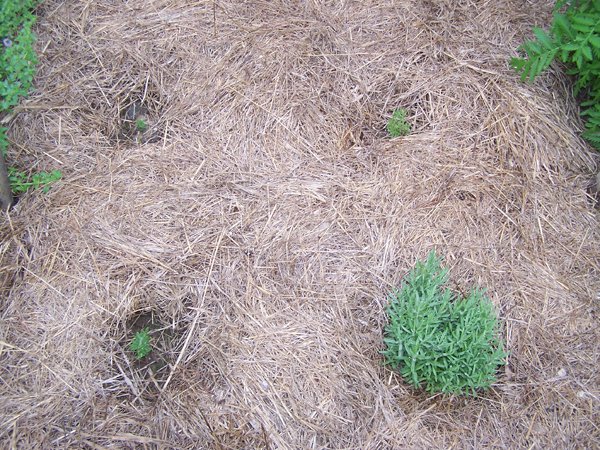
Common names: English lavender, Old English lavender
Flower: purplish-blue flower clusters on spikes 2” – 3” long at top of stems, highly scented, blooms July - September
Leaf: opposite leaves, gray-green, white and felty, narrow 2” long, fragrant
Semi-evergreen perennial, 2’ – 3’ high, most grow in Zones 5 – 9, Hidcote survives in Zone 4
Cultivation: Sunny location. Open to discourage fungus. Well-drained, sandy soil with lime. pH 6.5 – 7.5. Take 4” – 8” stem cuttings in spring or fall. Divide or layer plant. 1½’ – 2’ apart. Remove faded flowers. Prune in late autumn or spring. Too fertile soil reduces hardiness. Mulch in winter. Can overwinter inside in cool sunny room with little water and no feeding.
Medicinal:
• Tea for:
• Headaches
• To calm nerves
• As mild sedative
• Mild pain killer
• Cools burns
• Insect stings
• In oil for:
• Warning: lavender oil may be poisonous <2 drops, acts as narcotic
• Throat infections
• Skin sores
• Inflammation
• Rheumatic aches
• Anxiety
• Insomnia
• Depression
• Apoplexy
• Cramps
• Is an anti-spasmodic
Culinary:
• Jams
• Vinegar
• Use small amount as savory herb in stews
• Leaf is bitter
Other:
• Dried flowers repel moths
• Fresh flowers rubbed on skin repels flies
Sources:
Taylor’s Perennials
Garden Flowers
Right Plant, Right Place
Tansy Tanacetum vulgare also Chrysanthemum vulgare
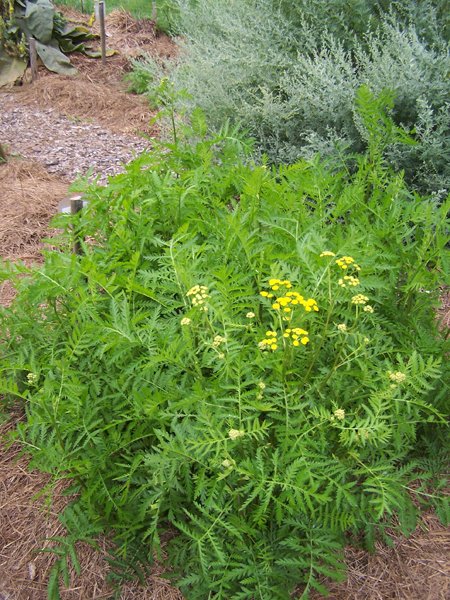
Common names: scented fern, stinking Willie, bitter buttons
Flower: dense clusters of small, button-like yellow flowerheads, flat, mustard yellow at ends of stems, flowers July - October
Leaf: feathery, fern-like, dark green, narrow, lance shaped with deeply toothed leaflets, alternate on long stem, scented
Extremely hardy perennial, Zones 3 – 9, roadsides, abandoned land, waste places
Cultivation: Full sun or partial shade. Well-drained not too wet soil. Divide roots spring or fall. 2’ – 3’ apart. Invasive. Needs frequent thinning and dividing. Resists frost. Will grow in same place for decades.
Medicinal: WARNING: Use in moderation, potentially toxic. Do not use in pregnancy.
• Leaves for tea for:
• Colds
• Stomach ache
• Intestinal worms
• Poultice for cuts and bruises
• Brings on menses
• Anti-spasmodic
• Flowers and leaves for infusion for:
• Cuts and bruise
• Rheumatism
• Sprains
• Can irritate skin
Culinary:
• Use leaf with rhubarb
• Rub on meat
• In sausage, meat pies, omelettes, stuffings
Other:
• Grow near fruit trees to repel insects
• Flower for golden dye
• Leaf deters flies, wrap meat in leaves to preserve
• Put under carpets to repell pests
• Deters ants and mice
• In compost for potassium content
Sources:
Field Guide to Wildflowers
Taylor’s Perennials
Wildflowers

Congratulations @goldenoakfarm! You have completed the following achievement on Steemit and have been rewarded with new badge(s) :
Click on the badge to view your Board of Honor.
If you no longer want to receive notifications, reply to this comment with the word
STOP